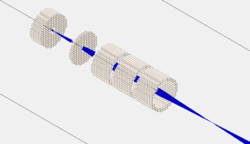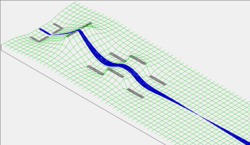Electron Gun: Difference between revisions
| Line 49: | Line 49: | ||
[[File:Simulationtopview.png|350px|Image: 350 pixels]|thumb|upright=1.5|alt=ASimulation of the focused electron beam with Wehnelt cylinder and Einzel lens (Top-Down Cross-Sectional View)]] | [[File:Simulationtopview.png|350px|Image: 350 pixels]|thumb|upright=1.5|alt=ASimulation of the focused electron beam with Wehnelt cylinder and Einzel lens (Top-Down Cross-Sectional View)]] | ||
[[File:Simulationisoview.png|250px|Image: 350 pixels]|thumb|upright=1.5|alt=ASimulation of the focused electron beam with Wehnelt cylinder and Einzel lens (Isometric View) | [[File:Simulationisoview.png|250px|Image: 350 pixels]|thumb|upright=1.5|alt=ASimulation of the focused electron beam with Wehnelt cylinder and Einzel lens (Isometric View)]] | ||
[[File:Simulationpotentials.png|250px|Image: 350 pixels]|thumb|upright=1.5|alt=ASimulation of the focused electron beam with Wehnelt cylinder and Einzel lens (Potential Field) | [[File:Simulationpotentials.png|250px|Image: 350 pixels]|thumb|upright=1.5|alt=ASimulation of the focused electron beam with Wehnelt cylinder and Einzel lens (Potential Field)]] | ||
==Equipments & Components== | ==Equipments & Components== | ||
Revision as of 15:10, 8 February 2022
Electron Guns have been used since the late 1940s in cathode ray tube (CRT) televisions and monitors.
The design of our electron gun can be understood through its two separate functions: electron emission and electron acceleration. Namely, to first introduce electrons into the system and then to accelerate these electrons, in a controlled manner, towards a target.
The introduction of electrons is done through thermionic emission. An electric current is passed through a filament which will then undergo Joule Heating. Thermionic emission will take place once the filament is sufficiently heated. This introduces electrons into the system.
The acceleration is achieved by differentially biasing electrodes within the electron gun to create an electric field that will accelerate the electrons towards the target in a controlled manner. The last clause requires more than mere potential differences but electrostatic lenses such that the electron beam can be coaxed into a desired trajectory. Broadly, both these objectives are achieved by having an acceleration section followed by a focusing section.
Directly following Thermionic emission, the electrons are subject to an accelerating potential. This accelerating potential is provided by an electrode (termed the anode) which is held at a positive potential difference from the filament. This causes electrons emitted from the filament to be accelerated towards the plate. Working in tandem with the anode is the Wenhelt Cylinder. Once accelerated past the anode, the beam is focused, again, with an Einzel lens.
These two, loosely defined, steps should result in an electron beam that is focused on a target. The target could be anything from a screen coated in phosphorous (to show the beam spot) to a Faraday Cup which can then be connected to a current measurement device.
Team Members
Aliki Sofia Rotelli (A0236272H)
Lai Tian Hao (A0236351L)
Lim En Liang, Irvin (A0173028J)
Tan Chuan Jie (A0154805E)
Idea
There are two parts to this project. The first would be to create the electron source which seems to be done with the use of a Lenard/Crookes tube [1]. Secondly, we would want to focus this electron beam into a spot with the use of a homemade magnetic lens (probably a solenoid of some form). We could perhaps perform a measurement of the focal length with respect to the magnetic field strength of the lens.
Concepts
Thermionic Emission
Published by Richardson in 1901, Richardson's emission law proposed that current from a heated wire depends exponentially on the temperature of the wire with the mathematical form:
where J is the emission current density, T is the temperature of the metal, W is the work function of the metal, k is the Boltzmann constant, and id definded as:
where is a material-specific correction factor that is typically of order 0.5, and is a universal constant given by:
x
where m and are the mass and charge of an electron, respectively, and h is Planck's constant.
The Wehnelt cylinder
The Wehnhelt cylinder is a negatively biased cylinder located right after the filament. It influences the focusing of the electron beam and the electron emission from the filament. When tuned appropriately, the Wenhelt Cylinder, together with the anode, aids in the emission of electrons from the filament by creating a net electric field from the attractive (to the electrons) anode and repulsive Wehnelt. Being negatively biased, the Wehnelt cylinder also acts as a convergent electrostatic lens which focuses the electron beam path from the filament to the anode.
Einzel Lens
Like the Wehnelt Cylinder, the Einzel lens is also an electrostatic lens. In this electron gun, the Einzel lens is made of three cylindrical tubes in series along the direction of the electron beam. Due to the electrostatic symmetry, the ions do not lose energy through the focusing process. In operation only the middle Einzel is actively biased (positively). The other components of the lens being held at ground potential.
Simulated Proof of Concept
Simulations were performed in SIMION based on a proposed arrangement of the components mentioned above.
With parameters:
Wehnelt: -200V
Anode: 1000V
Middle Einzel: 500V



Equipments & Components
High Vacuum (HV) Components (SUBJECT TO CHANGE)
- Roughing Pump
- Turbo-Molecular Pump
- KF-25 Stainless Steel vacuum bellow (1 meter)
- CF-40 Stainless Steel Tee
- CF-40 Stainless Steel Cross
- CF-40 Stainless Steel Viewport
- CF-40 Stainless Steel High-voltage Dual Port Feedthroughs (x2)
- CF-40 Stainless Steel Multi-Pin Feedthrough, Double-Ended
- CF-40 to KF-25 Stainless Steel Flange Adapter
- CF-40 Straight Connector (x2)
Electrical Components
- High Voltage Power Supply Unit (PSU) (up to 5kV)
- Current Controlled PSU
Beam Focusing Components
- Enzil Lens
- Pair parallel plates (x2)
Measurement Components
- RBD's 9103 USB Picoammeter, (Alternative: Multimeter)
- High Vacuum Digital Gauge, with range ~ mbars
- Thermocouple
Other Components
- Filament (Possible Choice)
- Tungsten (W)
- Lanthanum Hexaboride(LaB6)
- Cerium Hexaboride(CeB6)
- Phoshors
- Zinc sulfide(ZnS) (Copper/Silver Activated)
- CF-40 Copper Gaskets









